| 1 | India’s most common snake |
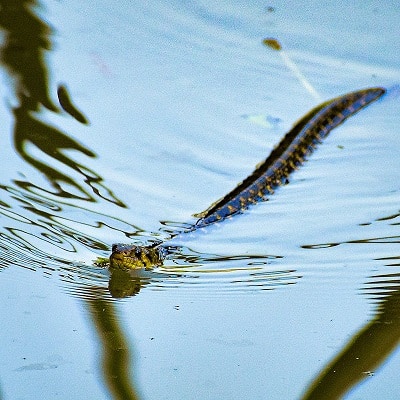
Though the Indian cobra is far more famous as an icon of terror, and the Russell’s viper kills the most people, neither of those are India’s most common snake. Instead, the master of numbers is the checkered keelback, a water inhabitant. This species measures 1-1.5 metres, and is absolutely everywhere in India. They’re commonly found in rice paddies, lakes, ponds, swamps, marshland, and anywhere with a healthy mixture of water and moist countryside.
Checkered keelbacks are an aggressive and confident snake. They slither quickly, swim quickly, and acquire their prey using grappling and sheer determination. Checkered keelbacks are usually classified as non-venomous. It’s believed that there’s a slight venom secreted in their saliva, as bites often itch and swell slightly, but no humans have ever been killed. That said, checkered keelbacks won’t hesitate to bite defensively.
This species is found in almost every corner of India, particularly the centre. Rice paddy farmers meet them every day, as do weekend tourists exploring lakes. They’re also common in urban areas like universities, coping well with sewers and industrialised canals. Virtually any rice paddy in India has a chance of containing this wildly successful snake.
| 2 | No venom, but knows how to jump |
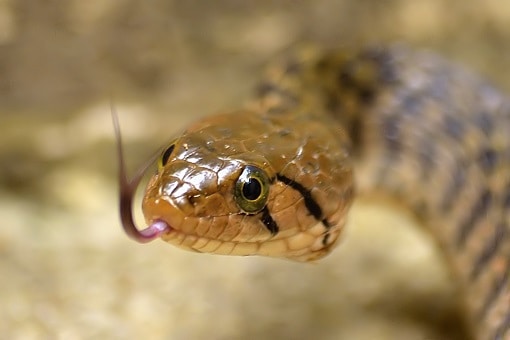
Some water snakes are small, humble creatures which peacefully eat small fish. Not the checkered keelback. This is an aggressive species which defends its lake or rice paddy with a passion. They don’t hesitate to bite people, and picking one up is a terrible idea. Checkered keelbacks have multiple rounded teeth, which are designed for gripping slippery fish, but can easily cause a bleeding gash.
The checkered keelback is a snake of a thousand skills, a serious venom being the only one lacking. The first is a bizarre ability to jump. By a sudden application of pressure in various points of its body, checkered keelbacks can propel themselves off the ground while thrashing in mid-air. Eastern brown snakes also possess this ability.
Despite being a water snake, checkered keelbacks are also strong tree climbers. In 2017, one was spotted 7 metres high in a neem tree, the tree whose bark is popular in skincare. They also mimic a cobra, by raising their neck straight and spreading their upper ribcage to look larger. Checkered keelbacks rarely stray far from water, and you’ll never find them in an arid rocky plain. But they’re perfectly comfortable on dry land, as long as the comfortable refuge of a lake is close by.
| 3 | Steals chicken from universities? |
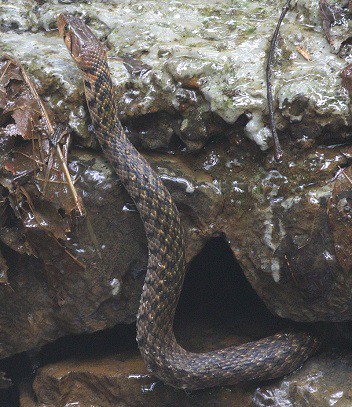
Though they require water, checkered keelbacks are highly flexible snakes, even to the point of being maniacs. In April 2015, one was observed stealing boiled rice and chicken from Jahangirnagar University in Bangladesh. These were pinched from the student canteen, and the next day the keelback returned for seconds. Cooked chicken is weird prey for a snake, but rice is stranger, as all snakes are carnivores. It was believed that industrial spillage into the local lake had wiped out their traditional frog prey.
The checkered keelback’s diet consists of a healthy mixture of amphibians and fish. Many species are confirmed in their diet, such as Asian common toads, common skittering frogs, Indian bullfrogs, and marbled balloon frogs. Checkered keelbacks are neither constrictors nor ambushing sit-and-wait predators. They’re active foragers, which prowl energetically around their lakes, which they know every corner of.
When they find a frog, they’ll simple grab it and attempt to swallow, by laboriously rearranging the slippery amphibian. Despite lacking hands, checkered keelbacks are experts at manipulating objects using their coils alone.
| 4 | Swallows prey underwater |
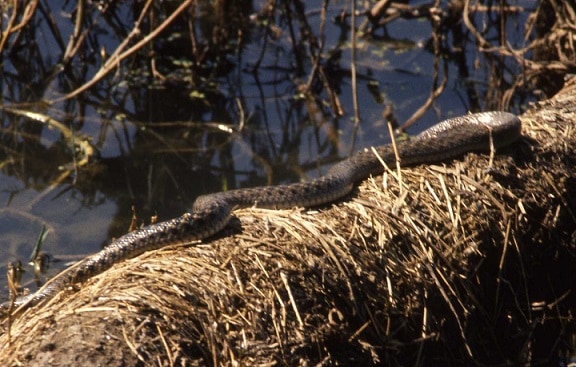
Checkered keelbacks are extremely cunning hunters. In India, rice paddies are often drained from one field to the next, through canals which allow proper distribution of water. Congested backups occasionally form with huge gatherings of fish, and checkered keelbacks have been observed to head for these greedily.
Checkered keelbacks are also capable of swallowing prey underwater. In Dhaka, the capital of Bangladesh, a checkered keelback was observed grabbing an Asian common toad in Dhanmondi lake. The toad desperately inflated its body, but the checkered keelback had a plan, and confidently submerged its entire body. When it resurfaced 4 minutes later, there was a large bulge in its stomach.
Though normally steady swimmers, checkered keelbacks are capable of huge bursts of speed when threatened. Their normal hunting strategy is to swim up to a frog slowly and cautiously, keeping still, and making no unnecessary movements. Once within striking distance, they’ll make a sudden darting lunge for their oblivious prey.
| 5 | Fakes its own death |
Checkered keelbacks aren’t idiots, and know that when faced with a 100 pound opponent, the odds are against them. Another reason they’re so common is advanced defensive tactics like severing their own tail. In 1993, scientists located a checkered keelback in Dac-Lac province, Vietnam. While holding its tail carefully, the keelback suddenly began trashing from side to side, rotating on its axis. Its tail then snapped off, between the 19th and 20th vertebrae, in a deliberate severing of its own body part. Tail severing (caudal autonomy) is found in dozens of snakes, and is an emergency resort for escaping a predatory bird, but highly effective.
Another checkered keelback trick is faking death. This happened in 2007 in Gujarat province, India. At first, the checkered keelback thrashed and bit, but over 2 minutes, gradually calmed down. Soon, its entire body was limp, its eyes were wide and unseeing, its muscles slackened, and its tongue lolled out of its mouth lifelessly. The keelback was playing dead, in a trick used by fellow species like the western hognose snake.
Creepily, its eyes continued to move the whole time, following the scientists around the room menacingly, while its body was statue-esque. With so many varying skills, it’s no wonder that checkered keelbacks dominate the lakes of India.
| 6 | The common keelback empire |
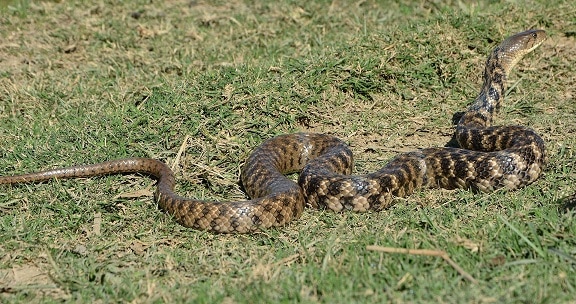
Checkered keelbacks (Fowlea piscator) belong to the 9-member Fowlea family, of which they’re easily the most common. They inhabit all of India, except the desert region of Rajasthan bordering Pakistan, and the high peaks of the Himalaya. Their range also includes Bangladesh, Burma, western Thailand, and Nepal. They were originally thought to live in Sri Lanka, but in 2022, these populations were split into a new species: Fowlea unicolor.
Despite these breakaway rebels, checkered keelbacks still have a colossal territory. The second most common member is the yellow-spotted keelback (Fowlea flavipunctus), occupying Taiwan, Hong Kong, and Vietnam.
At birth, checkered keelbacks measure 17-19cm. The maximum adult length was 175cm. Freaky morphs have been spotted around, including a leucistic version. This is similar to albinism, with pigments such as melanin massively decreased, except that the eyes are normally coloured. This was found in Mizoram, northeast India, and true albinos have also been spotted. Checkered keelbacks have round pupils, and their eyes are mainly brown, but with a gold ring around the pupil.
| 7 | Outsmarted by frogs |
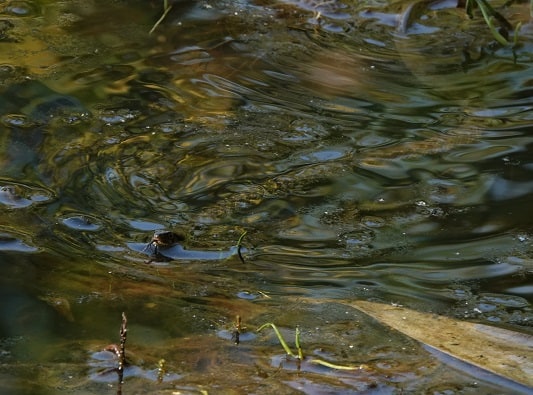
Checkered keelbacks don’t bother sticking to one time period. They dislike being restricted by the moon or sun, and can be found slithering during both day and night. This is an energetic snake which can grab a frog from the stone wall of a well, before jumping into the well to swallow in peace.
Checkered keelbacks can also appear in suburban backyards, as long as they’re relatively moist. But not all their exploits end in success. Frogs don’t roll over and accept their fate, and in May 2019, an epic tail happened in Karnataka, India. A 75cm checkered keelback seized an Indian bullfrog by its hind legs, on the edge of a small manmade swamp. The frog struggled valiantly, and began inflating its body, to form a huge balloon which the keelback couldn’t swallow. The keelback didn’t give up, and began forcing the frog’s body against a concrete wall for leverage.
After 1 hour, it swallowed the frog’s head, but was now unable to breathe, with a balloon lodged in its throat. The bullfrog’s forelimbs continued to grip and grasp at vegetation. Finally, the annoyed keelback gave up, regurgitated the bullfrog, and swam away.
| 8 | Frogs recognise their scent |
Science has also proven that local Indian frogs recognise the scent of the checkered keelback. Being such a dangerous predator, a bully which won’t quit until forced, evolution has given the local frogs a healthy detection radar. Larval skipper frogs (a confirmed prey of checkered keelbacks) were exposed to various scents. With dragonflies and Mozambique tilapia, they didn’t respond. But when exposed to walking catfish, Jerdon’s bullfrog, Indian bullfrogs and checkered keelback scents, the frogs reacted with alarm.
Life is hard for a checkered keelback in other ways as well. They’re often collected in fishing nets, crushed under the weight of fish above them. They can be run over on roads directly next to rice paddies, while the 20-50cm younglings are scooped up by wading birds, monitor lizards, cats or even large fish (maybe preventing their future demise). They’re even eaten by fellow snakes like the many-banded krait.
Pollution is another problem, particularly pesticide and herbicide runoff into lakes. Checkered keelbacks often survive this toxic sludge spillage, but their frog food base can be decimated. Many wetlands are being converted to housing estates, removing their habitat.
| 9 | Lays over 100 eggs |
Despite these problems, checkered keelbacks are so widespread that they’re nowhere close to going extinct. Maybe in the occasional village, but across India, they’re simply too powerful. One backup they have is laying a vast egg total, one of the highest of any snake. Totals of 8 to over 100 have been observed. No matter how many younglings perish in the competitive Indian wilds, there’s always a handful to fulfil the next generation.
Checkered keelbacks are also unusual in that the males stay with females for several months, perhaps for an entire summer of love. They lay their eggs in March and April, in a variety of locations: termite mounds, rotting vegetation, manure piles, crevices in walls. Each egg measures 1.5-4cm, and the mothers often guard them.
The appearance of common keelbacks correlates with the weather. Though they’re actually nearby still, they appear to vanish during the hottest, driest weather. When monsoon season explodes into action, the checkered keelback reappears in force.
| 10 | ID signs to remember |
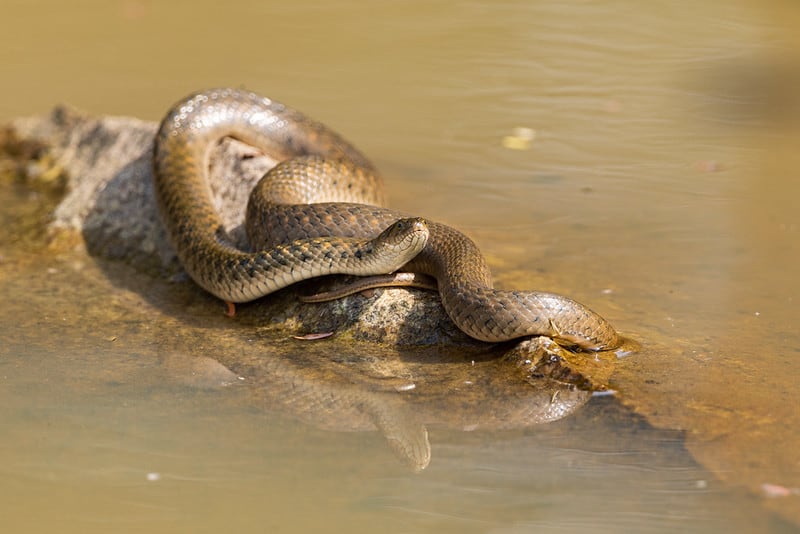
Checkered keelbacks vary in colouration, but are usually a mixture of yellow and black. Rather than huge blotches, they have complex patterns, with rapidly alternating lines and squares. A consistent ID feature is two thin black lines on each side of the face. The first begins below the eye, while the second starts just behind the eye. Checkered keelbacks have a dark grey tongue, which grows darker towards the tip.
Many snakes have ecological parallels around the world. A black mamba occupies a similar niche to the Australian coastal taipan, while the peaceful grass snake acts similarly to a US garter snake. A great parallel of the checkered keelback, halfway across the world, is the Brazilian smooth snake. Both are water snakes with a very slight venom, which reach 1.5 metres and prowl aggressively through marshland, rather than hiding in reeds timidly. Both eat amphibians, and they even share an ability to play dead, and an angry reaction when bothered by humans.
